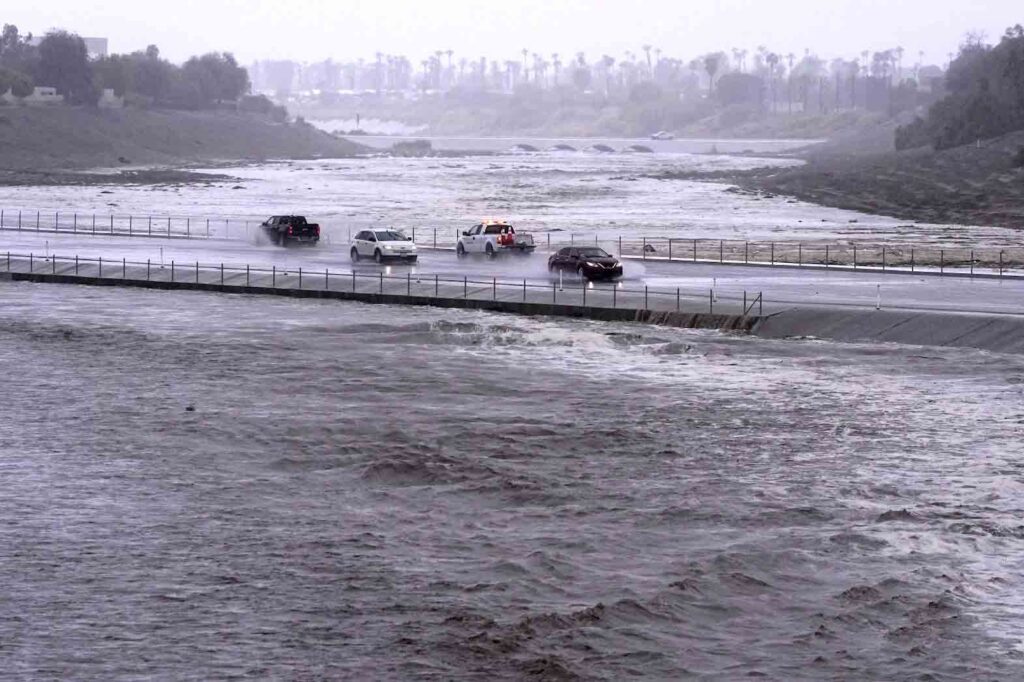Storm Hilary soaks Southern California, heading to Nevada

Vehicles cross over a flood control basin that has almost reached the street, Sunday, Aug. 20, 2023, in Palm Desert, Calif. (AP Photo/Mark J. Terrill)
LOS ANGELES — Tropical Storm Hilary drenched Southern California from the coast to the desert resort city of Palm Springs and inland mountains, forcing rescuers to pull several people from swollen rivers.
By early Monday, remnants of the storm that first brought soaking rains to Mexico’s arid Baja California peninsula and the border city of Tijuana, threatened Nevada and as far north as Oregon and Idaho with flooding.
Southern Californians were battling flooded roads, mudslides and downed trees.
“Thank God my family is OK,” Maura Taura said after a three-story-tall tree crashed down on her daughter’s two cars but missed the family’s house in the Sun Valley area of Los Angeles.
Hilary is just the latest major weather or climate disaster to wreak havoc across the U.S., Canada and Mexico. Hawaii’s island of Maui is still reeling from a blaze that killed more than 100 people and ravaged the historic town of Lahaina, making it the deadliest U.S. wildfire in more than a century. Firefighters in Canada are battling that nation’s worst fire season on record.
Southern California got another surprise Sunday afternoon as an earthquake with a preliminary magnitude of 5.1 hit near Ojai, about 80 miles (130 kilometers) northwest of downtown Los Angeles, according to the U.S. Geological Survey. It was felt widely and was followed by smaller aftershocks. There were no immediate reports of major damage or injury, according to a dispatcher with the Ventura County Sheriff’s Office.
Read also: Flooding in California: What are ‘atmospheric rivers’?
Tropical Storm Hilary first made landfall in Baja California on Sunday in a sparsely populated area about 150 miles (250 kilometers) south of Ensenada. One person drowned. It then moved through mudslide-prone Tijuana, threatening the improvised homes that cling to hillsides just south of the U.S. border.
The first tropical storm to hit Southern California in 84 years, Hilary dropped more than half an average year’s worth of rain on some areas, including Palm Springs, which saw more than 3 inches (8 centimeters) of rain by Sunday evening.
In September 1939, a tropical storm that roared into California ripped apart train tracks, tore houses from their foundations and capsized many boats, killing nearly 100 people on land and at sea.
Sunday was the wettest day on record in San Diego, with 1.82 inches (4.6 centimeters), the NWS said in a post on X, formerly known as Twitter. The previous record was on Aug. 17, 1977, when 1.8 inches (4.5 centimeters) of rain fell in the area post-Hurricane Doreen.
The Los Angeles Unified School District, the nation’s second largest school system, said all campuses would be closed on Monday, along with other districts across the region. San Diego schools postponed the first day of classes from Monday to Tuesday.
The Palm Springs Police Department said in a statement Sunday that 911 lines were down and that in the event of an emergency, residents should text 911 or reach out to the nearest police or fire station.
As skies were clearing Monday in California, the National Weather Service warned of flooding underway in the Mount Charleston area west of Las Vegas. Forecasters said the threat for flooding in states farther north on Monday was highest across much of southeastern Oregon into the west-central mountains of Idaho “with record breaking precipitation” forecast for Monday morning.
Forecasters at the National Hurricane Center, meanwhile, were watching a disturbance in the Gulf of Mexico that now has an 80% chance of developing into a tropical disturbance or tropical storm before reaching the western Gulf coastline on Tuesday. Forecasters urged people along the coast in northern Mexico and Texas to monitor the system, adding that tropical storm watches or warnings may be issued later Monday.
Want stories like this delivered straight to your inbox? Stay informed. Stay ahead. Subscribe to InqMORNING
Click here for more weather related news."

